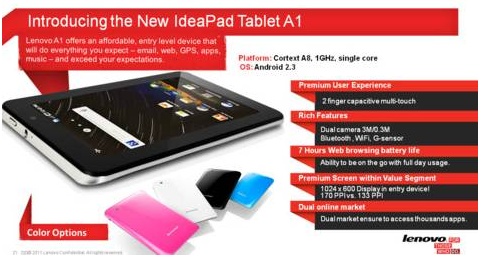It’s no secret that Android tablets need a lot of catching up to get ahead of the game. I’m going to expand on a few points from this article and talk about where slates can do better to become better accepted by consumers.







1. Make them talk better with peripherals
One thing that makes notebooks and netbooks a preferred choice by the regular consumer is that most of the stuff they already have–speakers, keyboards, external drives–already work with that device. With tablets, it’s a bit more tricky since you often need to buy additional cables and adapters like the one above, or even have to get an extra app in the off-chance that you do get peripherals to work. There are manufacturers moving to creating better docks (such as Asus through the Eee Transformer) but a tablet needs one simple thing quite frankly: a built-in USB port like that in the Acer Iconia.
2. Printing should be fool-proof
Like on the desktop, printing should become a standard with all apps that need them. It’s really frustrating that you need to hack together a solution just to get your tablet and your printer to play well with each other. One easy solution is the USB port I mentioned above, but another is just giving Android the ability to send data to printers in the same network. Also, the solution has to be systemwide so that apps can easily bake in the ability without any additional blood, sweat and tears from the dev. A docking solution like the one above is also an option, though it still needs yet another peripheral.
3. Chrome, get your tablet on!
Ever wondered why Chrome isn’t part of Android even though they are both from the same company? I do too and Google is indeed taking steps to make it so (hopefully it comes sooner rather than later). What Chrome needs on the tablet are a few of the basics: syncing with your desktop browser, easy to use tabs, extension support and of course, it has to stay lightning quick.
4. Beef up the storage
This one might take a while. Even though we technically should be seeing huge drops in price of flash memory due to the widespread adoption of this form of storage as well as through Moore’s Law, we’re not seeing it on our tablets. Many buyers expect their bigger device to have bigger storage rather than having the same as their smartphones. MicroSD is a solution but it would be better if we had 256GB on deck, don’t you think? Let’s hope that manufacturers get this going in the next couple of years at the very least.
5. For crying out loud, handwriting recognition!
We used to call it a slate, now it’s a tablet. That’s because slates are used for writing and tablets require you to chip away your letters or in the high-tech sense, tap on your keyboard to write. Tablet PCs are still more widely used in business because of this and some makers like HTC and Samsung have seen the light, thankfully, and are providing solutions. It’s best though if every tablet, at the least all coming Ice Cream Sandwich ones, have handwriting recognition available and for all apps at that.
6. Make external storage slots a standard
Oddly enough, while microSD is a mainstay on most smartphones, it mysteriously vanishes when it comes to a few Android tablets. Every tablet should have a slot for external storage so people aren’t forced to pick and choose files to save on their device. Number 4 above isn’t coming any time soon so external slots are really a must. Even better are ones that can accept regular SD cards.
7. It’s not a toy, it’s a workstation
I’ve tried explaining to people that I do indeed use my tablet for work but no matter how I present it, all they see are my apps for games and social networking. Okay, so it might be partially my fault for not putting in work apps in there but seriously, have you really done any real work on it? One way to break away from this line of though is to make tablets less than “oversized smartphones” and more like “portable workstations”. It’s a niche that netbooks have filled up which sadly should be under the tablet’s domain already. The new ThinkPad might soon break the mold though.
8. Lower pricing
Lenovo is on the right track here when it announced its $199 IdeaPad A1 last week. It’s a decent offering and we’re hoping that other tablet makers will follow suit with more powerful devices. And it’s not just the consumers that will be grabbing those tablets. It will be enterprise customers as well, giving them the push they need to adopt tablets as part of their workflow and making it cheaper for everyone around by buying in bulk.











0 comments:
Your feedback is always appreciated. We will try to reply to your queries as soon as time allows.
Note:
1. Make sure to click the "Subscribe By Email" link below the comment to be notified of follow up comments and replies.
2. Please "Do Not Spam" - Spam comments will be deleted immediately upon our review.
3. Please "Do Not Add Links" to the body of your comment as they will not be published.
4. Only "English" comments shall be approved.